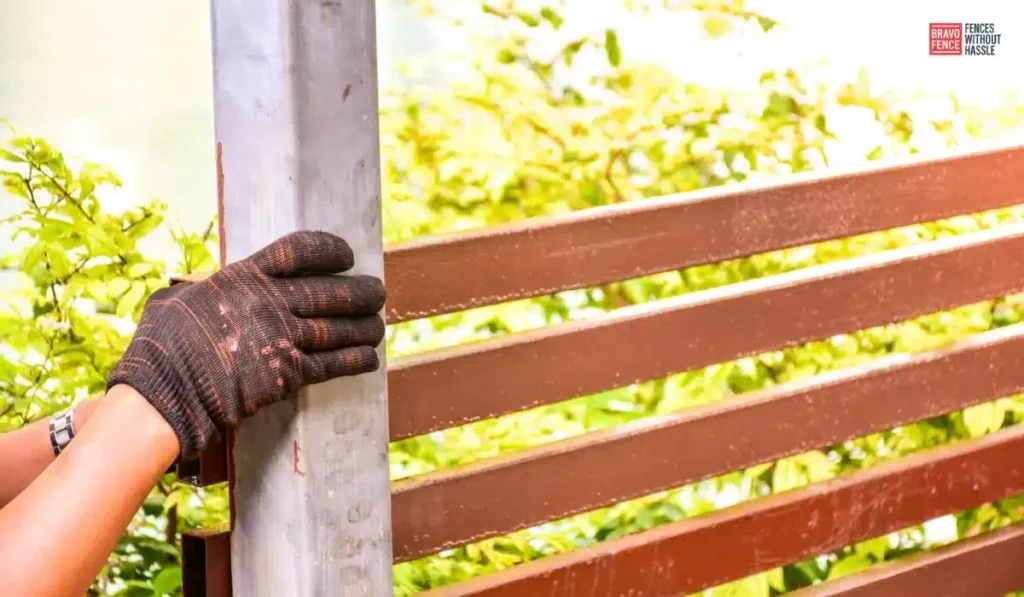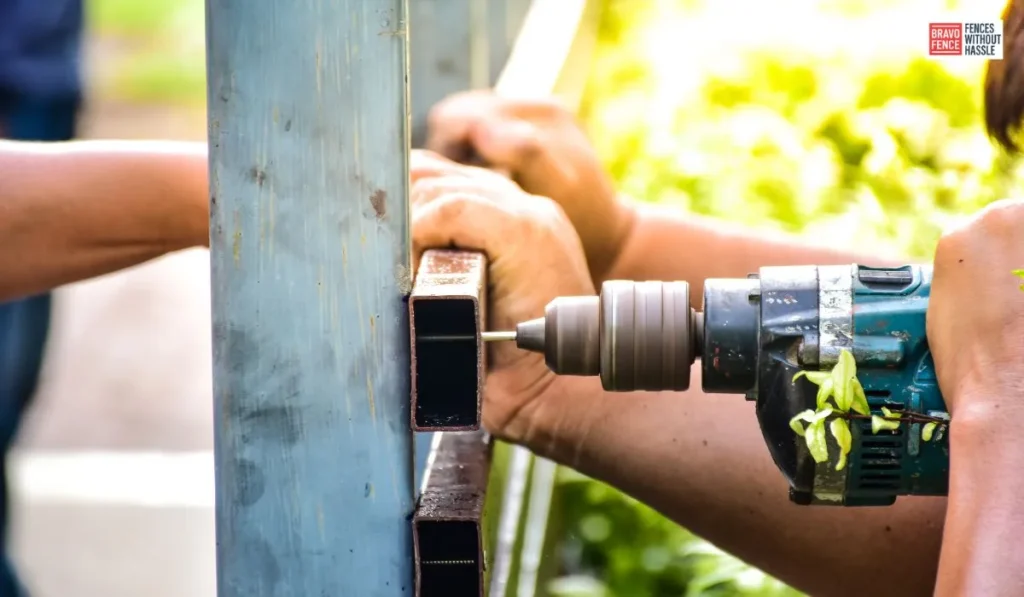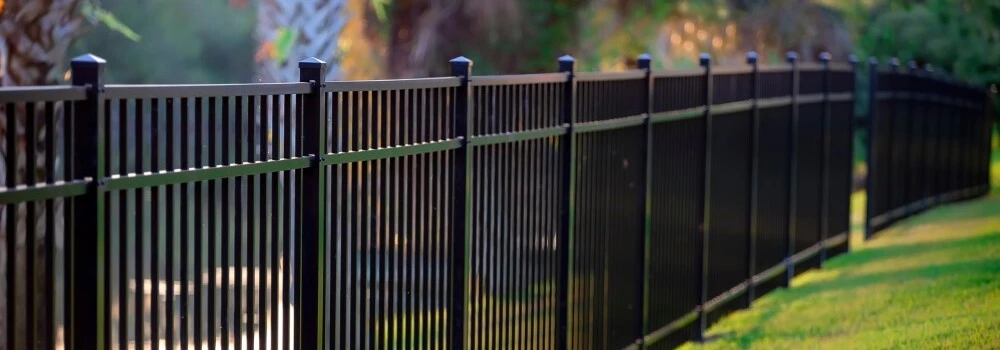
Is Welding or Replacement the Best Option for Damaged Steel Fences?
Steel fences are very handy for homeowners and business owners because they are durable, secure, and aesthetically pleasing.
However, like any other structure, a steel fence can be damaged over time for many reasons.
When an individual encounters a damaged steel fence, property owners are in a dilemma on whether to weld or repair the wall or change it altogether.
This article will take you through the nitty-gritty of steel fence repair.
It weighs the pros and cons of welding versus replacement and gives you an idea of how to conduct repairs at different times.
Introduction: Understanding Steel Fence Damage
Steel fences are environmentally resistant. Still, they do not withstand extreme conditions.
After many years, here are some factors that might lead to the deterioration of a steel fence:
Rust
One of the common problems with steel fencing is rust, especially if it needs to be treated or maintained correctly.
Rust prevents one from carrying out other activities since it might damage the fence structure.
Impact Damage
Even with a meager expectation, an accidental vehicle impact, heavy equipment accident, or fallen branches may cause the bending or breaking of steel fencing.
The impact damage can be reduced; hence, the damaged sections can be repaired instead of the entire system.
Wear and Tear
Continuous exposure to various weather conditions gradually wears off the protective coatings on the steel.
These then lead to corrosion and the final failure of the system.
Over time, some fence sections may weaken, implying a need for repair or replacement.
Ground Movement
Soil erosion, settling, or shifting can cause a steel fence post to lean or become loose.
While many of these common causative agents bring potential steel fence repair decisions into play, knowing their relative importance helps make a decision.
The Extent of Damage: To Weld or Not to Replace

The extent of damage also goes hand-in-glove with the decision to weld versus replace steel fence posts.
The following are some critical things that should inform the choice:
Type of Damage
Is the damage cosmetic, such as surface rust? Or is it more structural, such as a broken post or bent panel?
Minor problems may weld together, while much more severe damage means replacement.
Location of Damage
Damage at seams or joints can be welded over in places with less complicated access, but those areas bearing a critical load might need to be replaced entirely.
Age of the Fence
An older fence will likely be subjected to multiple deterioration areas; hence, replacement is a better investment than repeated repairs.
Types of Damage Usually Reassembled with Welding
Surface Rust
Rust can be sand-blasted out and coated using protective paints.
Small Cracks or Breaks
Fractures in the steel in small portions can be welded back.
Bent Sections
Panels or posts that are bent slightly can be straightened and strengthened by welding.
If the damage lies in this range, welding can be applied to restore a broken steel fence.
Advantages of Welding for Steel Fence Repairs
Compared with other methods, welding has several advantages when it comes to repairing damaged steel fences:
Cost and Time Efficiency
Welding can be much more affordable than replacing an entire fence, especially if the damages are not severe.
It requires less time than a whole section of a wall so that the property owners can regain functionality without waiting very long.
Key Natural Look and Feel
With welding, the fences’ original look and structural integrity can be maintained.
This may be especially crucial when fences have historical or sentimental value.
Benefits of Welding Over Replacement in the Environment
Welding is more environmentally friendly than the replacement of a steel fence.
First of all, replacement often causes damage to the old material, leading to waste and pollution in the environment.
Welding enables the utilization of existing materials, and this aspect reduces the overall impact on the environment.
When Replacement Would Be Better
However, there are occasions wherein replacement may be more advisable than to weld them as follows:
Extreme or Extensive Damage
When widespread rust exists, the structure has several breakdowns, and a considerable section of the fencing is already damaged.
Replacement may be more viable than repair. Multiple welds would yield temporary results and may cost more.
Structural Weaknesses
Poorly constructed fences with deep rust that affected the post may be better replaced.
Although surface-corrected, these compromised sections could fail in the future.
Long-term Cost Comparison
While welding may look cheaper, the ongoing repairs will surely add up.
Making a replacement, ideally with new materials, can give a fresh start, and the newer ones may last longer than those worn out.
Welding vs. Replacing Steel Fences: Advantages and Disadvantages
Advantages of Welding
- Cost-Effective: This is the cheapest option when it comes to minor fixing.
- Time-Consuming: Repairs usually take too much time.
- The Appearance of Originality is Preserved: The old looks of the fence do not get altered.
Disadvantages of Welding
- Not Durable: Repairs, like a new fence, can only last for a short time.
- Expertise: A majority of the operations need the hands of a professional.
Advantages of Replacing
- Permanent Solution: A new fence may not need repair for years.
- Modern Materials: Newer fences may be made of advanced materials that do not rust and wear.
- Structural Integrity: New installations are a clean slate with no previous weaknesses.
Disadvantages of Replacement
- Higher Initial Cost: The initial cost can be significantly more than welding.
- Disruption: Replacement may take more time and effort, causing temporary disruptions.
Safety Considerations: Welding Hazards and Replacement Factors
Safety measures are a must, either when welding or replacing.
In the case of welding, safety steps taken should be the following:
Protective Gears
Welders should wear helmets, gloves, and fireproof clothes.
Ventilation
The area should be well-ventilated to avoid inhaling dangerous fumes.
Work Area Safety
Clear the area of inflammable materials and keep it safe.
For replacement purposes, safety steps still apply:
Heavy Lifting
Use proper lifting methods when lifting large fence sections.
Equipment Safety
Use the right equipment and tools and operate them according to the procedure.
Steel Fence Replacement Issues
There are several issues with the replacement of a steel fence:
Material Disposal
Pulling out and evacuating the old fencing material can be heavy-duty and require some permit or authorization.
Installation Time
A complete replacement can be a long process, sometimes even extending to more than just a day or two, depending on the scope of the fence to be replaced and how involved the task is.
Potential Landscape Disruption
Removing an existing fence can disrupt surrounding landscaping.
This may include additional labor to restore the area.
Environmental Impact: Welding vs. Replacing Steel
Repair or replacement with steel fences can be highly impactful on the environment:
Sustainability
Sustainability is also encouraged through welding because it will extend the life of the material.
Welding diminishes the generation of waste.
However, replacement creates a tremendous amount of garbage only if controlled.
Availability of Recycling
Both processes offer scope for recycling: The metal scrap of the welding process can usually be reused, and, according to local recycling facilities, fencing materials can sometimes be recycled.
Waste Reduction
Replacement with repair will generally produce less waste output, which is often a massive consideration for environmentally sensitive property owners.
DIY or Professional Help: What’s the Best Approach?
While working with a steel fencein atlanta, most property owners need clarification about whether to do the repairs themselves or seek professional help.
Here are some points to consider on each side:
DIY Welding Repairs
- Skill Level: With experience in welding and the necessary equipment, minor repairs are possible. However, this might lead to more problems when the repair needs to improve.
- Cost Savings: DIY solutions can save money, but concealed costs could be associated with messing up or lousy repairs.
Professional Expertise
- High Extent of Damage: If the damage is at a high extent or structural, it should be the case regarding safety and quality standards when consulting a professional.
- Complex Installations: With experience and proper tools, complex installations ensure a long-lasting outcome.
Typically, the welding or replacement aspect can only be determined with the help of an Atlanta professional steel fence installer..
Conclusion
Damage to a steel fence and when to weld or replace it have always been difficult for property owners.
Each method has its merits and demerits, depending on the damage’s severity and the fence’s age, thus weighing against the overall goals of the property.
For minor damages, welding may be the most economical and time-effective way to return to its original state while not harming the environment.
Replacement might be the wisest option for long-term peace of mind for severe and extensive damage.
Ultimately, information on subtle concepts in steel fence repair, like the specifics on the repair of the steel fence in Atlanta, can empower homeowners to make informed decisions that meet their preferences.
FAQs
How long will it take to weld a broken steel fence?
Generally, the time taken for welding repairs varies with the degree of damage but could take from hours to some days for large projects.
Can the rust be ground out and the damaged part treated to prevent recurrence?
Yes. If you see your steel fence is damaged, look at the damage and consider whether you need an expert opinion to decide if welding or replacing is the better option.
What would you recommend for preventive maintenance on a steel fence?
It’s always wise to ask any professional installer providing warrantied repairs or installations, but routine checks include rust assessment, protective coatings, and adequate draining around the posts to help your steel fence last as long as possible.
Tags: Complete Guide to Fence Damage Solutions, Everything You Need to Know About Welding Vs Replacement, Inspiration and Tips on Steel Fence Repair, Inspiration and Tips on Steel Fencing Solutions, Top Ideas and Insights About Fence Restoration
